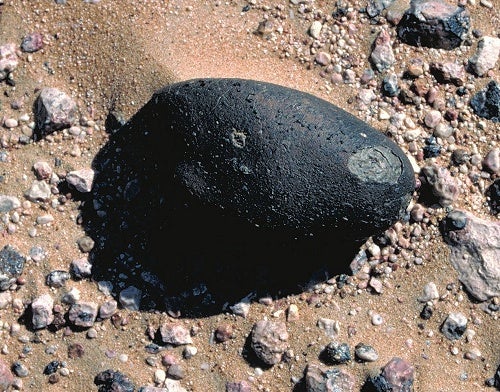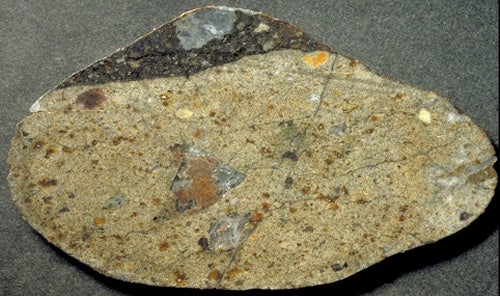A fist-size meteorite named Sayh al Uhaymir 169 experienced three lunar impacts while on the Moon before a fourth ejected it and sent it earthward, says a team of planetary scientists who studied the meteorite’s isotope chemistry. While the meteorite’s lunar provenance has been known since it was found in early 2002, both its link to a specific crater and the history of its wanderings are new.
The researchers, led by Edwin Gnos (Bern University, Switzerland), analyzed the meteorite and found it consists mostly of impact melt breccia. This is a common lunar rock type built from fragments of other rocks broken, melted, and welded together by impact shocks. Examining the meteorite’s elemental composition, Gnos and his team found it was richer in the radioactive element thorium than any lunar rock known. This gave a clue to where on the Moon the meteorite came from.
Detailed analysis of a variety of isotopes in the meteorite let the researchers date when it was exposed to violent blasts from impacts. This showed the meteorite’s rocky material first formed in a gigantic impact that occurred 3.909 billion years ago.
“We consider this first impact as the one that made the Imbrium basin,” says Gnos. This impact is a benchmark in lunar history, and its best previous age-date was 3.85 billion years. The new finding suggests a somewhat earlier date. The second and third impacts recorded by the meteorite happened about 2.8 billion and 200 million years ago.
“The second impact made the crater Lalande,” says Gnos. “And the third impact was from a crater close to Lalande. It may have been Lalande A or one of two unnamed craters nearby. We can’t rule out any of them.” The 2.8 billion year date is determined by radioactive decay in the meteorite, while the 200 million year date comes from the meteorite’s exposure to cosmic rays.
A fourth impact came less than 340,000 years ago and threw the meteorite off the Moon entirely. “It had to be a crater a few kilometers in size,” says Gnos, pointing to impact modeling studies. “It also has to be in the neighborhood of Lalande.”
After expulsion from the Moon, the meteorite drifted in the solar system until it was captured by Earth about 9,700 years ago, falling to the ground in the Sayh al Uhaymir region of Oman.
“The 340,000-year age of the last impact,” explains Gnos, “is limited by the rock’s time on the ground, plus the time it would have taken to travel from the Moon to Earth.”
The scientists are especially pleased that the meteorite is a piece of a lunar area unlike any other. Around Mare Imbrium and Oceanus Procellarum, on the northwest side of the Moon’s Earth-facing hemisphere, lies an unusual region — the Procellarum KREEP terrane, or PKT. This region contains rocks highly enriched in potassium (K), rare-earth elements (REE), and phosporous (P). Thorium and uranium commonly accompany these elements also. The Gnos team’s report appears in the July 30, 2004, issue of Science.
Says Randy Korotev (Washington University), writing in the same issue of Science, “The chemical differentiation of the Moon, as it formed its core, mantle, and crust, was asymmetric.” The last stage of crustal formation, he notes, left a chemically anomalous region, rich in incompatible elements, that was then struck by the Imbrium impactor.
Thorium-rich rocks lie in the Montes Carpatus and extend southeast from there. The crater Lalande, which is 15 miles (24 kilometers) across, lies right on a thorium “hotspot.” The crater is nearly on a line between the craters Copernicus and Ptolemaeus, although it’s closer to the latter. It is easily visible, even in small telescopes, starting about a day after First Quarter Moon.
Regarding the 3.909-billion-year date for the Imbrium basin impact, Gnos says, “We think the meteorite’s age should solve the long discussion over the age of Imbrium.” He adds, “The new age will also slightly change the lunar time scale based on crater counting,” pushing dates back further in time.











